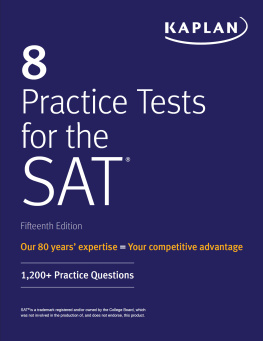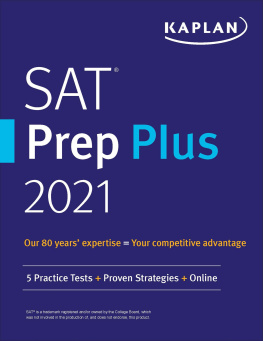Table of Contents
Guide
Page List

Editor-in-Chief
Alexandra Strelka, MA
Contributing Editors
Dr. Brandon Deason, MD; M. Dominic Eggert; Kathryn Sollenberger, MEd; Glen Stohr, JD
Special thanks to our faculty authors and reviewers
Michael Collins; John Evans; Jack Hayes; Jo LAbbate; Bird Marathe; Melissa McLaughlin; Robert Reiss; Gail Rivers; Gordon Spector; Bonnie Wang; and Ethan Weber
Additional special thanks to
Matthew Callan; Paula L. Fleming, MA, MBA; Joanna Graham; Adam Grey; Rebecca Knauer; Michael Wolff; and the countless others who made this project possible
SAT is a registered trademark of the College Board, which was not involved in the production of, and does not endorse, this product.
This publication is designed to provide accurate information in regard to the subject matter covered as of its publication date, with the understanding that knowledge and best practice constantly evolve. The publisher is not engaged in rendering medical, legal, accounting, or other professional service. If medical or legal advice or other expert assistance is required, the services of a competent professional should be sought. This publication is not intended for use in clinical practice or the delivery of medical care. To the fullest extent of the law, neither the publisher nor the editors assume any liability for any injury and/or damage to persons or property arising out of or related to any use of the material contained in this book.
2020 Kaplan, Inc.
Published by Kaplan Publishing, a division of Kaplan, Inc.
750 Third Avenue
New York, NY 10017
All rights reserved under International and Pan-American Copyright Conventions. By payment of the required fees, you have been granted the non-exclusive, non-transferable right to access and read the text of this eBook on screen. No part of this text may be reproduced, transmitted, downloaded, decompiled, reverse engineered, or stored in or introduced into any information storage and retrieval system, in any form or by any means, whether electronic or mechanical, now known or hereinafter invented, without the express written permission of the publisher.
ISBN: 978-1-5062-7441-6
TABLE OF CONTENTS
This book will help you prepare for the two math sections of the SAT: the no-calculator section and the calculator section. Your combined raw score from both these sections is converted to a scaled score of between 200800.
Start by becoming familiar with the structure of the two math sections. Then work your way through the chapters of this book and do as many of the practice sets as you have time for between now and test day. Be sure to review the explanations carefully. (Review them even for questions you got right, to make sure your calculations and reasoning are sound.) As your test date approaches, take the Math Practice Test found at the end of this book. Do this in a quiet environment and use the indicated timing guidelines. Again, be sure to review the explanations, found at the end of each chapter, to reinforce what youve learned.
If youre still looking for more practice questions once youve finished the question sets in this book, register your book at kaptest.com/moreonline to get even more practice.
The SAT Math Test
The SAT Math Test is broken down into a calculator section and a no-calculator section. Questions across the sections consist of multiple-choice questions and student-produced responses (Grid-ins).
| No-Calculator Section | Calculator Section | Total |
| Duration (minutes) | 25 | 55 | 80 |
| Multiple-Choice | 15 | 30 | 45 |
| Grid-in | 5 | 8 | 13 |
| Total Questions | 20 | 38 | 58 |
The SAT Math Test is divided into four content areas: Heart of Algebra, Problem Solving and Data Analysis, Passport to Advanced Math, and Additional Topics in Math.
| SAT Math Test Content Area Distribution |
Heart of Algebra
(19 questions) | Analyzing and solving equations and systems of equations; creating expressions, equations, and inequalities to represent relationships between quantities and to solve problems; rearranging and interpreting formulas |
Problem Solving and Data Analysis
(17 questions) | Creating and analyzing relationships using ratios, proportions, percentages, and units; describing relationships shown graphically; summarizing qualitative and quantitative data |
Passport to Advanced Math
(16 questions) | Using function notation; creating, analyzing, and solving quadratic and higher-order equations; manipulating polynomials to solve problems |
Additional Topics in Math
(6 questions) | Making area and volume calculations in context; investigating lines, angles, triangles, and circles using theorems; working with trigonometric functions and complex numbers |
A few math questions might look like something youd expect to see on a science or history test. These crossover questions are designed to test your ability to use math in real-world scenarios. There are a total of 18 crossover questions that will contribute to subscores that span multiple tests. Nine of the questions will contribute to the Analysis in Science subscore, and 9 will contribute to the Analysis in History/Social Studies subscore.
Elimination and Guessing
Note that there is no penalty for guessing on the SAT, so it is in your best interest to answer every question. Ideally, taking a strategic guess means eliminating one or more choices and guessing from the rest to boost your chances of getting the question correct. However, if you are pressed for time, taking a guess on a potentially time-consuming questioneven without eliminating any of the choicescan help you get to more questions and get more points out of a section.
A Note about Grid-lns
You will see an occasional question without answer choices throughout the Math chapters of this book, starting in the next chapter. On the SAT, several of these Grid-in questions appear at the end of each Math section. Instead of bubbling in a letter, youll enter your responses to these questions into a grid that looks like this:

If you are gridding a value that doesnt take up the whole grid, such as 50, you can enter it anywhere in the grid as long as the digits are consecutive; it doesnt matter which column you start in. Gridding mixed numbers and decimals requires some care. Anything to the left of the fraction bar will be read as the numerator of a fraction, so you must grid mixed numbers as improper fractions. For instance, say you want to grid the mixed fraction 512. If you enter 51/2 into the grid, your answer will be read as 512. Instead, enter your response as 11/2, which will be read (correctly) as 112.. Alternatively, you could grid this answer as 5.5.
A repeating decimal can either be rounded or truncated, but it must be entered to as many decimal places as possible. This means it must fill the entire grid. For example, you can grid 16 as .166 or .167, but not as .16 or .17.

















